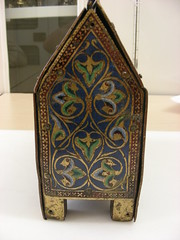By Stuart Frost
 Where did the summer go? Is it really September already? Time certainly seems to be flying by. Work is progressing on the project at a rapid rate. My main priority at the moment is six short gallery films for the Medieval and Renaissance Galleries. Each film focuses on one object, two examples of which are illustrated here. Click on the image for more information about the object and the film.
Where did the summer go? Is it really September already? Time certainly seems to be flying by. Work is progressing on the project at a rapid rate. My main priority at the moment is six short gallery films for the Medieval and Renaissance Galleries. Each film focuses on one object, two examples of which are illustrated here. Click on the image for more information about the object and the film.
The films will delivered in the galleries via small screens carefully placed alongside the artworks to which they relate. One of the main aims of these films is to encourage visitors to spend more time looking at the actual objects and to highlight elements which they might otherwise miss. Placement of the screens is crucial.
Each film will be around three minutes in length. This might appear to be very short but visitors will view the films whilst standing. Audience research indicates that under these circumstances anything of longer duration is unlikely to hold peoples’ attention. Watching a film when you’re at home sat in a comfortable armchair is a completely different scenario. Regular museum visitors will know how the ability to concentrate decreases in direct proportion to the amount of time you’ve been on your feet. When you have children in tow, or a less enthusiastic partner standing at your shoulder, attention spans are reduced even further. Anyone who visits museums and galleries regularly will know how quickly saturation point can be reached.
Over the last couple of weeks we have been working on planning schedules for the filming with the production companies we’ve appointed to make them. The draft scripts were written earlier this year. All of the films involve filming on location and filming of objects at the V&A. The location filming will begin next week. Flights were booked and travel arrangements confirmed some time ago. The locations on mainland Europe include Florence, Aachen and Prague. The film company has had the challenging task of negotiating permissions to film inside a large number of historically important buildings including churches, palaces and cathedrals.
The idea of filming in beautiful cities like these is needless to say, very exciting. However anyone who assumes that those involved will have plenty of leisure time to take in the views and soak in the atmosphere is sadly mistaken. The schedules are very tight and in order to maximise the available time the days will be very long. Early starts will be essential as some of the filming has to be completed before the buildings open to the visiting public. The number of the locations means moving from one place to another throughout the day.
Two of the six films are part of an established series of How was it made? films at the V&A. These two films will follow contemporary artists as they replicate techniques used to make two objects, a sixteenth century woodcut and a twelfth century casket with enamelled plaques. Both of these films will help visitors appreciate the great skill that was required to make the objects them see. The films also highlight that techniques which originated over 500 years ago are still with us, although usually utilised in a distinctly modern way.
I’ll document work on the films with a series of digital images and blog updates over the coming weeks.
All of tle films are now complete. You can view them here
http://www.vimeo.com/album/148359
Please do let us know what you think.